
On the 3rd of July I was out at Dundreggan for a couple of meetings, and in between them there was a gap of an hour or two. I decided to go and have a look for some invertebrates on some of the trees near the buildings there, thinking especially of some aspen trees (Populus tremula) along one of the burns. However, on my way to them, I made a slight detour to a couple of bird cherry trees (Prunus padus) at the far end of the field where our tree nursery is situated.
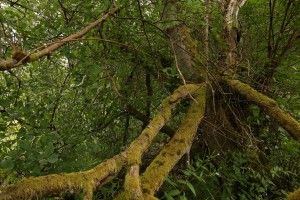
These are interesting trees, because some of their branches have fallen down, but haven’t broken off, so they are still growing, with much of their foliage either close to the ground itself or reaching up to about head height. This makes the leaves ideal for looking closely at, in a search for invertebrates or galls, for example, and it was this opportunity that drew me to the trees just now.
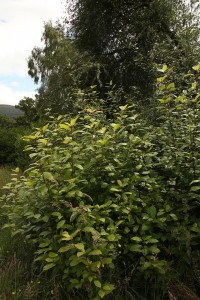
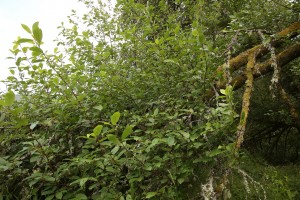
I’ve spent time looking at these two trees in previous years, often finding interesting things on them, and I was hoping to do so again now.
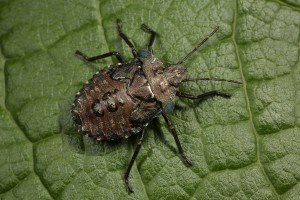
Almost immediately I spotted a relatively large insect on one of the leaves, and looking closely at it I saw that it was a bug and most likely a nymph – one of the developmental stages that the young of true bugs, as this group of insects are known as, go through on their way to becoming adults.
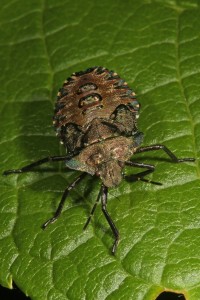
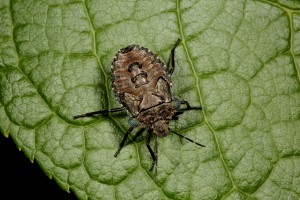
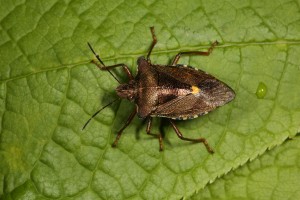
I didn’t recognise which species it was straight away, but checking later on the excellent British Bugs website I saw that it was the final instar nymph (ie the last larval stage) of the red-legged shield bug (Pentatoma rufipes), which is also known sometimes as the forest bug. The co-author of that website is Joe Botting, who’s done several surveys of Hemiptera, (the insect Order to which true bugs belong) for us at Dundreggan, and when I contacted him he confirmed that my identification of the nymph was correct.
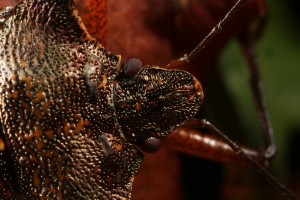
While I was watching and photographing the nymph, some movement on a nearby leaf caught my eye – it was another bug, and as it turned out it was an adult of the same species (Pentatoma rufipes). Bugs like this are generally relatively sedentary and unconcerned by people. They don’t rush away when approached, so I was able to take a number of photos of both the adult and nymph, including some high magnification macro images that show the details of the compound eyes etc.
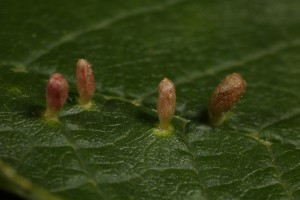
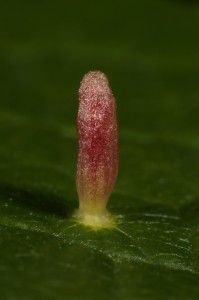
Once I was satisfied that I had some good images of the bug, I began looking at other leaves on the same tree, as I’d seen some galls induced by a mite (Phyllocoptes eupadi) on some of them a few weeks previously.
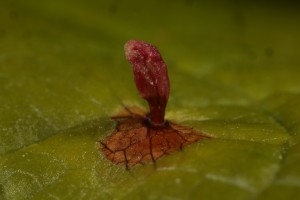
Then, they had been quite small and relatively unspectacular, so I was hoping that by this time they would have developed further, and have reached their full size and coloration. Almost immediately I began seeing some of these galls, and I wasn’t disappointed in them! Still only 3 mm or so tall, they were bright red in colour, and standing up from the leaves like miniature scarlet fingers.
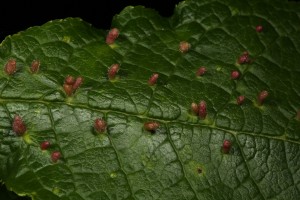
Each individual gall contains a larva of the mite inside, and, by means still not understood by biologists, it somehow induces the bird cherry to not only produce this unusual growth formation to house the larva, but also to provide special nutritive cells that the larva feeds on. After a while, when the larva is fully grown, it pupates and the adult mite emerges, whereupon it feeds by sucking sap from the cell tissues of the leaves.
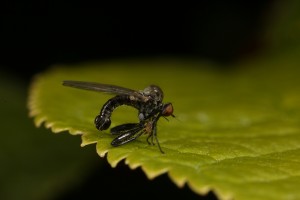
While I was photographing the galls my attention was drawn by a small black shape on a nearby leaf. Turning my camera towards it, I managed to get a couple of photographs of an interesting-looking fly, but then was unable to catch it, as it flew away too quickly. Unlike the shield bugs, flies such as these are very skittish around people and I find it a challenge often to both take a photograph of one and catch the specimen for identification by an expert – in most cases it’s not possible to identify small flies like this from photographs alone. I’m hoping I may be able to get some information on this one though, as it appeared to be shedding the exoskeleton, of exuvium, of an earlier stage of its lifecycle. Thus, I’m waiting to see if Peter Chandler, the specialist on flies who helps me with identifications, is able to provide any details about it.
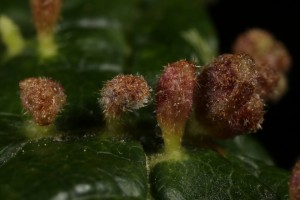
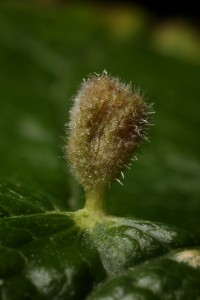
My interest kept being drawn by the galls however, and I noticed some that were more advanced in their development, as indicated by them being covered in tiny hairs.
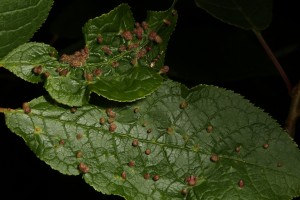
While I was looking at one particular cluster of two gall-covered leaves, I spotted a tiny bright shape in amongst the galls themselves. It was a tiny micro-moth, sitting perfectly still on the leaf. I took several photographs of it, getting closer with each one, and as I did so, I saw that it had a beautiful metallic gold pattern on its wings. When seen in extreme close up like this, it looked absolutely stunning, and I marvelled at its miniature beauty – it was a tiny, living work of natural art.
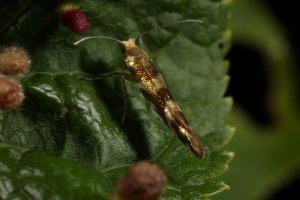
In years gone by I didn’t pay much attention to micro-moths, lumping them all together as the sort of uniform grey-brown Lepidopteran pests that make a meal out of the clothes in our wardrobes! However, more and more I’m now discovering that they are a remarkable group of insects, often with brilliant coloration and special markings, like this one.
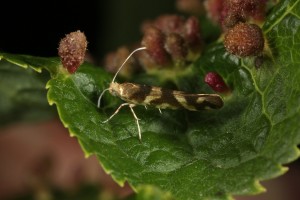
I had no idea what species it was, but I contacted Bob Heckford, a specialist in micro-moths who helps me with identifying them, and he replied that it’s a common species called the golden argent (Argyresthia goedartella). As it turned out, he said he’s writing an article about a rare form of this moth, called ‘literella’, and he asked me to keep an eye out for it, as he’s looking for some photographs to accompany his article.
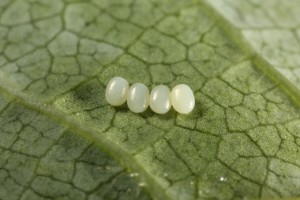
Turning over another nearby leaf on the bird cherry, I saw some small white blobs on its underside. Looking at them through my hand lens revealed that they were eggs, most likely of a micro-moth, judging by their tiny size. Using my high magnification macro lens at its maximum image size setting, I took a photograph of the eggs, and then left them in place to hatch out and develop as caterpillars. I’ll never know what species they are from, as it’s unlikely I’ll be able to find that particular leaf again, out of all the thousands on that bird cherry.
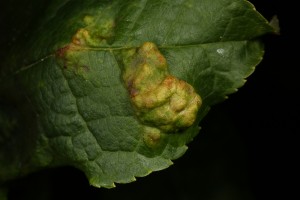
On another leaf, I saw some blisters – differently-coloured swollen sections of the leaf, raised up from the main surface. These looked like a sort of blister gall, but I hadn’t seen this type of gall on a bird cherry before. Since photographing it I’ve been attempting to find out what it is, so far without success. There is a similar-looking gall induced by a fungus (Taphrina deformans) that occurs on some members of the Prunus genus, such as peach. It’s called peach leaf curl, but so far I haven’t come across any references to this occurring on bird cherry, so it’s a bit of a mystery – I’m waiting to hear from a gall expert, to see if she can shed any light on the causative agent for this gall.
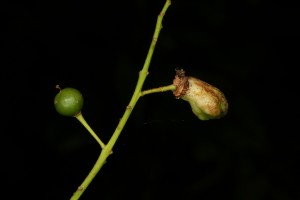
Another gall that I saw on the tree was more easily identifiable. This took the form of distorted and swollen fruits on the bird cherry, and these are induced by a fungus (Taphrina padi). It causes the fruits to become elongated, reaching several times their normal length, and they become hollow inside. Closely-related fungi in the genus Taphrina induce the tongue galls that form on the cones of common alder (Alnus glutinosa) and the witches broom galls that occur on birch trees (Betula spp.).
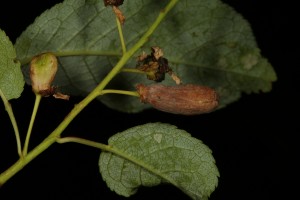
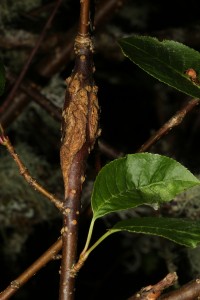
A section of stem near the galled fruits was swollen, and from checking on the Internet, I’ve found that this is possibly also due to the same fungus (Taphrina padi).
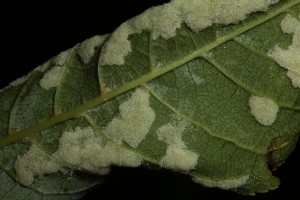
Close by, I found some other leaves with unusual growths on them. These took the form of white sponge-like shapes spreading across the lower surface of the leaves. I’d never seen anything like this before, but it was quite spectacular and I reckoned it should be possible to find out what it was. I took a series of photographs of it, and also collected some specimens, in the event that I’d need to get a specialist to check the actual material in order to make a definitive identification of it.

After sending out a few emails, and getting some useful hints along the way, I got a reply from Margaret Redfern, the author of the definitive guidebooks to plant galls in the UK, that these galls were probably induced by a mite (Eriophyes distinguendus). She emphasised the word ‘probably’ because although the shape and form of a particular gall is a good indicator of the causal agent, in cases like this the actual adult mite itself would be needed to make an absolute confirmation of the species.
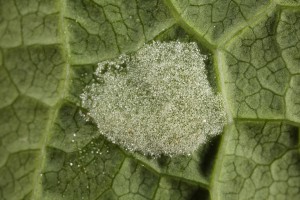
‘Felting’ like this is common on the leaves of plants, and a patch of such felt is known as an erineum (plural erinea), and consists of a mass of modified hairs tightly packed together. Many species of mites induce felt galls like this on a range of plant hosts, and the mites live and feed in amongst the hairs. The erinea are often pale to begin with, but can darken in colour as they age.
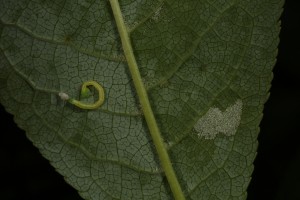
Quite a number of the leaves on this part of the bird cherry were hosting these erinea, and in some cases the galls were covering virtually all of the surface of the leaves they were growing on. In one case, there was just a small erineum on the underside of one particular leaf, but almost beside it, there was a small caterpillar, which looked like it was newly-emerged from its egg. I haven’t been able to get this caterpillar identified yet, and it may turn out to be too young for a positive identification to be made.
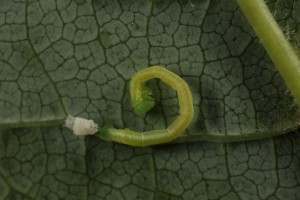
By this time the two hour interval between my meetings was almost over, and I realised that I’d spent the entirety of it looking at this two bird cherry trees, and all the other life they were supporting. I never did make it to my original intended destination for the day – a stand of aspen trees along the lower section of the Aspen Burn, and only about 300 metres from the bird cherry. I wasn’t disappointed though, as there had been more than enough life on the bird cherry to hold my attention and keep me taking lots of photographs during the day.
Here in Korea, Phyllocoptes eupadi is also observed on Prunus padus.
Prunus padus does not grow to more than shrub size (perhaps 4-5 m high, understory shrub). It is the first woody plant to leaf out in the spring, and it attracts a host of insects.
I really enjoyed listening to your TED presentation on the restoration of the ancient Caledonian forest.
Many thanks for the positive feedback about my TedX presentation, and for the information about Prunus padus in Korea.
Great, but no mention of the red and black beetle I have alongside the ladybirds on my cherry tree. They are more slender than the young ladybird bettles and much quicker in their movement.
Are they a pest or are they eating aphids like the ladybird?
You are obviously very knowledgable on the subject so I hope you can help.
Regards
Roy
Hi Roy,
Thanks for your comment on my blog. I’d need to see a photo of the black and red beetle you’re referring to in order to answer your question definitively, but my first response is that it’s unlikely the beetle will be eating aphids, and I doubt if it is a pest species either.
With best wishes,
Alan
Hello, my Prunus padus’ are badly infected by the fungus have hardly any undistorted fruit. Can you suggest any treatment?
Hi Hanna,
Thanks for your comment. No, unfortunately I don’t know of any treatment for this. I suspect you’ll just have to accept it this year as a phenomenon of Nature, and I suspect that next year there will be less effect from it. Many of these sorts of species interactions are occasional or cyclical, with a year of heavy infestation followed by years with very little sign of the galls. I hope this is helpful! With best wishes, Alan
Hi Alan,
Just a tidbit of news that should interest you and others at TFL; the US Forestry Service has concluded in a study that trees save more than 800 lives a year in the US by removing air pollution from the air. Here’s the link to Dr. Weil’s news item on this:
http://www.drweil.com/drw/u/WBL02414/Menopause-and-Caffeine.html
Hi Dennis,
Thanks for providing this link – I hadn’t seen that news myself.
With best wishes,
Alan
Most interesting, Alan. What high magnification macro lens do you use?
Hi Paul,
Thanks for your comment. The lens is the Canon 65 mm MP-E one, which goes from 1x magnification (ie life size on a camera with a full frame sensor) to 5x (ie 5 times life size). It’s a remarkable lens, not very easy to use at first, but it gives great results, and I use it a lot. I also have the Canon 100 mm 2.8 macro lens, which gives a magnification of up to 1x maximum – the 65 mm takes over from there.
With best wishes,
Alan
Your blog is a real lesson in the wonder of nature, which is all around us if only we’d properly look.
Hi Julie,
Many thanks for your comment, and I’m glad you’re appreciating my blogs, and the wonder of nature!
With best wishes,
Alan
Fascinating and informative!
Thanks for the wonderful ‘travelogue’, Alan.
J
Hi Janet, Thanks for the comment – I’m glad you’re finding my blogs interesting still!
With best wishes,
Alan